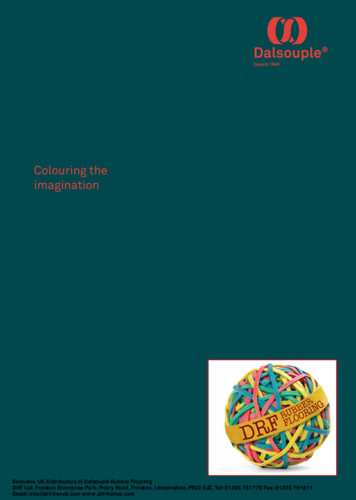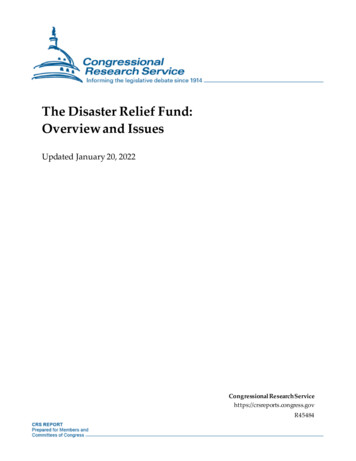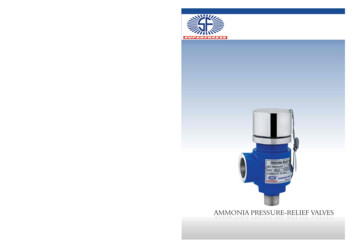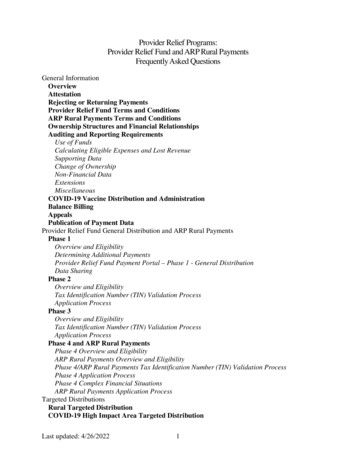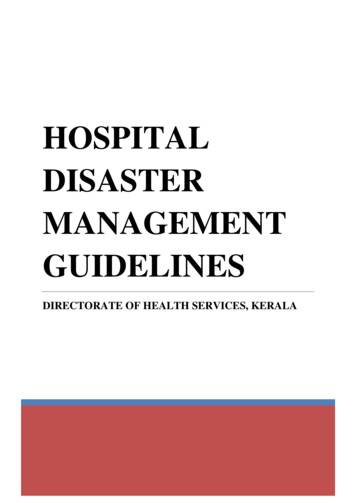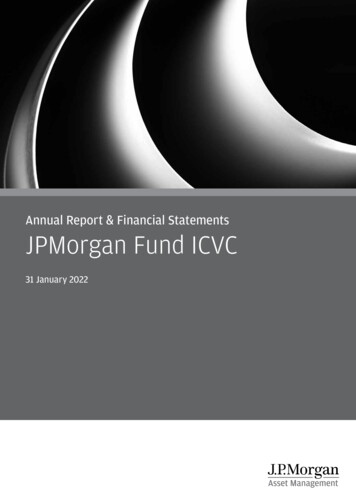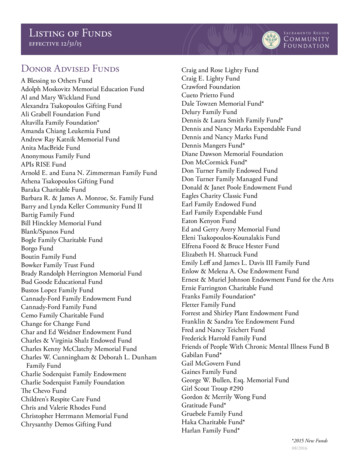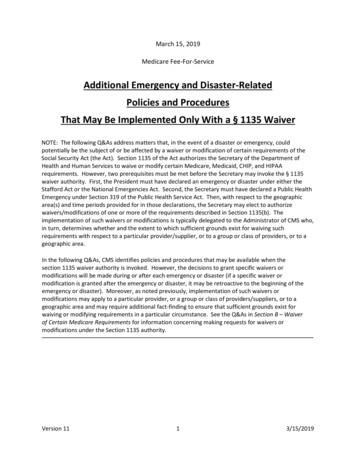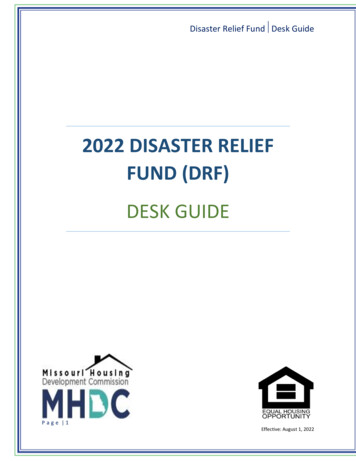
Transcription
Disaster Relief Fund Desk Guide 2022 DISASTER RELIEFFUND (DRF)DESK GUIDEP a g e 1Effective: August 1, 2022
Disaster Relief Fund Desk Guide ContentsIntroduction . 3General Information . 4Financial Processes . 5Housing Assistance. 8Home Repairs/Modifications . 11Operation Expenses . 16Income Eligibility . 17Direct Assistance Timeframe . 18Termination and Grievance Procedures . 18Prioritizing Assistance . 19Monitoring . 19Grant Close Out. 21Appendix A – Initial Grant Documents. 23Appendix B – Client File Forms . 25P a g e 2Effective: August 1, 2022
Disaster Relief Fund Desk Guide IntroductionPurposeThe Disaster Relief Fund (DRF) is intended to assist Missouri communities impacted by severe weatheror other natural disasters in recovery efforts. DRF funds should be utilized to quickly identify and assistlow- to moderate-income households that have either become homeless or are at risk of becominghomeless due to severe weather or other natural disasters.Eligibility RequirementsDeclared DisasterDRF Funds become available in the instance of a state issued disaster declaration (Governor); or afederal disaster declaration (President).IncomeAll DRF funds must be used to serve households at or below 100 percent of the Area Median Income(AMI). The AMI for each county in Missouri is defined by the Department of Housing and UrbanDevelopment (HUD). Form DRF-213 Maximum Income Limits provides the current DRF AMI to be utilizedand is available on the MHDC ms/disaster-relief/Housing StatusThose assisted with DRF funds must meet either the HUD HEARTH Category 1, Category 2, or Category 4definition of homelessness, due to the effects of the declared disaster. Households must be able toattest to and/or document housing status eligibility.* Category 1 – Literally HomelessoIndividual or family who lacks a fixed, regular, and adequate nighttime residence, meaning: Has a primary nighttime residence that is a public or private place not meant forhuman habitation; Is living in a publicly or privately operated shelter designated to provide temporaryliving arrangements (including congregate shelters, transitional housing, and hotelsand motels paid for by charitable organizations or by federal, state and localgovernment programs); or Is exiting an institution where (s)he has resided for 90 days or less and who residedin an emergency shelter or place not meant for human habitation immediatelybefore entering that institution Category 2 – Imminent Risk of HomelessnessoIndividual or family who will imminently lose their primary nighttime residence, providedthat:P a g e 3Effective: August 1, 2022
Disaster Relief Fund Desk Guide Residence will be lost within 14 days of the date of application for homelessassistance; No subsequent residence has been identified; and The individual or family lacks the resources or support networks needed to obtainother permanent housing Category 4 – Fleeing/Attempting to Flee Domestic ViolenceoAny individual or family who: Is fleeing, or is attempting to flee, domestic violence; Has no other residence; and Lacks the resources or support networks to obtain other permanent housing*In the case of disaster, employees or family of employees who otherwise qualify, are eligible to receive Disaster Relief Funds.Agencies are expected to treat employees or family members receiving assistance the same as all other citizens receivingassistance.Description of Grant ActivitiesHousing AssistanceHousing Assistance is intended for individuals and families who are at risk of homeless, orfleeing/attempting to flee domestic violence. There is no limit on the amount of assistance that granteescan provide to households during the grant period, however, grantees should have a consistentassessment process in place along with policies and procedures to determine the extent of ahousehold’s need and how the housing intervention determination is being applied to all clients.Home Repair or ModificationsPayments for the costs associated with necessary repairs, due to the declared disaster, of homeowneroccupied single family homes. Homeowners assisted through this grant must lack resources andsupports to pay for the costs of these repairs on their own. Owner-occupied single-family homes can beassisted up to 15,000 per household; prior approval will be needed if funds exceed 15,000 perhousehold.Operations: Outreach, Casework, and Program AdministrationDisaster Relief Fund grantees can bill the DRF grant for operations expenses necessary to theadministration of DRF. This includes DRF-focused outreach efforts and case-work. Cost associatedProgram Administration cannot exceed 10% of the total award.General InformationContactsBelow are the MHDC – DRF contacts for funded agencies. Please direct all questions, concerns, andupdates to the State Initiatives Grant Administrator. Applications, completed grant agreementdocuments, and back-up documentation shall be submitted electronically through your agency portal inP a g e 4Effective: August 1, 2022
Disaster Relief Fund Desk Guide the online Grant Interface. Cost associated with Program Administration cannon exceed 10% of the totalaward.Please direct questions, concerns, and updates to:William HawkinsDisaster Response Coordinator920 Main, Suite 1400Kansas City, MO 64105William.hawkins@mhdc.com(816) 648-0547Please submit Back-Up Documentation electronically y mhdcWebsiteAll information and forms pertaining to the DRF program can be found on the MHDC website saster-relief/Financial ProcessesPayment ProcessBefore any funds can be released, all grant documents must be completed and received by MHDC.1. All current year grant documents are completed and received.2. All previous compliance issues are resolved (i.e., grantee is “in compliance”).Once all of the above criteria are met, MHDC will automatically disburse 25 percent of the total grantaward amount to the Grantee upon execution of the grant agreement. Grantee may back up disbursedfunds using the back-up form (DRF-208). To submit, funded agencies must log into their Agency Profileon MHDC’s Online Grant Interface and fill out the next available back-up follow-up form. All fields mustbe fully filled out on the online form. Agencies may not submit more than one back-up form per month.Any further submissions will need to be resubmitted the following month. Due to the nature of themonthly submission deadlines, monthly submissions will be accepted from the 2nd through the 1st of thefollowing month. For example, a submission between June 2nd and July 1st would count as your Junesubmission and no further submissions would be allowed between those dates.MHDC will automatically disburse funds in 25 percent increments on a monthly basis once sufficientback-up covering all previously disbursed funds has been received and approved. MHDC may advancefunds in increments greater than 25 percent at its discretion if sufficient back-up is provided. Please seethe sample disbursement chart below.P a g e 5Effective: August 1, 2022
Disaster Relief Fund Desk Guide Disbursement and Back-Up ExamplePercent of TotalGrant AwardAmount DisbursedPercent Backed Upand Approved25%(initial advance)0-24%50%25-49%75%100%50-74%75-100%Example 1:Grantee A is awarded 50,000.00 therefore 12,500.00 (25%) is advanced to Grantee A upon executionof the grant agreement. Once the grantee has expended those funds the grantee is ready to submitback-up for the next installment of funds. Grantee A submits back-up of expenses totaling 12,500.00(25%), once it is approved Grantee A will automatically be advanced a second installment of 12,500.00(25% of the grant award amount). Grantee has now been disbursed a total of 50% of their total grantaward amount.Example 2:Grantee B is awarded 50,000.00 therefore 12,500.00 (25%) is advanced to Grantee B upon executionof the grant agreement. Once the grantee has expended those funds the grantee is ready to submitback-up for the next installment of funds. Grantee B submits back-up of expenses totaling 25,000.00(50% of the grant award amount), once it is approved Grantee B will automatically be advanced asecond installment of 25,000.00 (50% of the grant award amount). Grantee has now been disbursed atotal of 75% of their total grant award amount.Example 3:Grantee C is awarded 50,000.00 therefore 12,500.00 (25%) is advanced to Grantee C upon executionof the grant agreement. Once the grantee has expended those funds the grantee is ready to submitback-up for the next installment of funds. Grantee C submits back-up of expenses totaling 41,000.00(82% of the grant award amount), once it is approved Grantee B will automatically be advanced asecond installment of 37,500.00 (75% of the grant award amount). Grantee has now been disbursed atotal of 100% of their total grant award amount.Back-Up ProcessGrantee is required to submit back-up of expenses to account for all DRF spending during the grantperiod. Back-up must be submitted after any advance of funds is made and before additional funds canP a g e 6Effective: August 1, 2022
Disaster Relief Fund Desk Guide be requested. MHDC requires grantees to complete a back-up form to account for all spending, convertit to a pdf, sign, then uploaded into the follow-up from in the Grant Interface.Supporting DocumentationPlease find a list below of the required supporting documentation for each type of expense reported atthe time of back-up: Housing Assistance:o Completed Back-Up Formo MIS report reflecting direct assistance paymentsHome Repair:o Completed Back-Up Form (include client’s last name in the detail section)Operating/Administration:o Completed Back-Up FormPlease note that any documentation outside of the requirements above should be saved in the agency’sclient files and made available during Grantee’s compliance audit.Incomplete/Ineligible Back-Up SubmissionsIf the Grantee submits a back-up form that is incomplete/ineligible, MHDC will notify the agency’s GrantInterface contact listed on the Site Contact Form via email that there is feedback regarding theirsubmission in their follow-up form. In the event that there is feedback, Grantee will need to resolve allfeedback and re-submit the back-up for a second review.Common Reasons for Feedback on Back-Up Submissions Certificate of insurance has expired Expenses incurred or paid outside of funding period Expenses paid outside of designated region Ineligible activities reported Missing/Incorrect files uploaded Incorrect/Missing information fields MIS reports were not included with the back-up or there is missing information on the report Electronic submission is illegible Missing signatures from authorized signatoriesFunding PeriodAll DRF funding provided to grantees must be used for expenses that are incurred, paid, and submittedfor payment to MHDC during the Grant Funding Period as defined in the Grant Agreement. If billing forsalary, pay periods must also incur completely within the funding period. DRF Housing Assistance, andHome Repair grantees may request a prorated payment for payroll taxes and/or insurance which coversany portion of the funding period but which was paid outside of the funding period.P a g e 7Effective: August 1, 2022
Disaster Relief Fund Desk Guide Submission RequirementsFunded agencies may submit back-up electronically through their agency profile at the following key mhdcHousing AssistanceEligible ActivitiesSecurity DepositsFunds may be used to pay for security deposit that is less than or equal to two months’ rent.Rental and Mortgage ArrearsA one-time payment of up to six months of rental arrears or mortgage arrears may be providedon behalf of households in need. Arrears can include late fees accrued by the household andcourt cost incurred due to the eviction being filed. Late fees resulting from grantee’s failure topay rent on behalf of a household by the deadline is not considered an eligible use of the grant.Grantees are encouraged to assist participants to establish payment plans and negotiatereduced arrears if possible. Rental Arrears in excess of six months are considered to be ineligiblefor reimbursement.Application FeesGrantees may pay application fees on behalf of eligible households.Rental AssistanceGrantees may provide monthly rental assistance payments on behalf of eligible households. Thepurpose of the grant is to provide assistance to stabilize households that have no otherresources and supports to pay their monthly rent amount.Mortgage AssistanceGrantees may provide monthly mortgage assistance payments on behalf of eligible households.The purpose of the grant is to provide assistance to stabilize households that have no otherresources and supports to pay their monthly mortgage amount.Last Month’s RentIf necessary to obtain housing for a program participant, the last month’s rent may also be paidon behalf of the household at the time the first month’s rent is paid. The last month’s rentalassistance cannot exceed one month’s rent.P a g e 8Effective: August 1, 2022
Disaster Relief Fund Desk Guide Utility DepositsFunds may be used to pay for standard utility deposits for gas, electric, water, or sewage.Utility ArrearsUp to six months of arrears for unpaid gas, electric, water, and sewage may be provided tohouseholds in need. Arrears can include late fees accrued by the household. Late fees resultingfrom grantee’s failure to pay utilities on behalf of a household by the deadline is not consideredan eligible use of the grant. Grantees are encouraged to assist participants establish paymentplans and negotiate reduced arrears if possible. Utility Arrears in excess of six months areconsidered to be ineligible for reimbursement.Utility AssistanceUtility assistance for gas, electric, water, and sewage may be provided on behalf of eligiblehouseholds. Expenses deemed non-essential (i.e., telephone, cable television, internet, etc.) areconsidered ineligible for reimbursement.Hotel/Motel VoucherWhere no appropriate emergency shelter is available for a homeless individual or family,grantee may provide hotel or motel voucher. It is the expectation that grantee work withhousehold to create a housing stabilization plan as well as to ensure household’s service andhousing needs are addressed.Essential ItemsLimited to one instance of assistance per household per month, Grantee can provide essentialsupplies limited to the following items:oooBaby care itemsHygiene itemsGroceriesCosts associated with the delivery of such supplies are eligible for reimbursement.Ineligible Housing Assistance ActivitiesRental arrears in excess of six monthsMortgage arrears in excess of six monthsUtility arrears in excess of six monthsExpenses that are non-necessities (e.g., telephone, cable television, internet, etc.)Late fees (when acquired by the service agency)P a g e 9Effective: August 1, 2022
Disaster Relief Fund Desk Guide Households with Rental SubsidiesHouseholds that receive a tenant-based or project-based rental subsidy are eligible to be assisted withtheir portion of their monthly rent amount only if they have no other resources, they are literallyhomeless or at imminent risk of homelessness, and the financial assistance for this use is non-recurring.Households with rental subsidies can be assisted with arrears, security deposits, and utilitypayments/deposits regardless of the aforementioned criteria.90-Day RecertificationThe purpose of the DRF grant is to provide ongoing support to participants in order to achieve housingstability. The Income Verification Worksheet (DRF-212) and verification of sources of income should becompleted at initial intake and updated every 90 days thereafter. At recertification, the sources ofincome should be current within 30 days. At recertification, grantees need to evaluate householdsassisted for both need and eligibility, including:1. Determination of whether or not the household composition has changed; and2. Verification that household’s annual gross income does not exceed 100 percent of AMI; andVerification that the household lacks sufficient resources and support networks to retainhousing without DRF assistance.Recordkeeping Requirements – Housing Assistance & ServicesRecordConsent FormHousingStatus/Proof ofneed IncomeWorksheet SupportingDocumentation ofSources ofIncome CriteriaPermits MHDC to review client fileVerifies safe, decent and sanitary housing Acceptable Forms of DocumentationMHDC form MHDC-114 is the onlyacceptable form of documentationSigned by the head of household within 30days of first instance of assistance.Documentation of household’s current livingsituation. Should include documentation ofdisaster-related impact.Documentation provided by participant todetermine amounts/types of assistanceneeded for the households to gain stabilityin permanent housing.If paying arrears, documentation shouldinclude the number of months paid.Details household’s annual income forprogram eligibility DRF-212 Income Verification SummaryWorksheetVerification of proof of gross annual incomeis needed for all members of the householdage 18 and over Pay stubs, SSI/SSDI award letter/print out,child support statement, EBT statement forTANFMHDC-112 Employer Verification may beutilized only if the source documentation MHDC form MHDC-114Letter from Emergency Shelter, hospital, orother institutionEviction and/or utility shut-off noticeCopy of lease agreement or billDisaster Relief Eligibility Certification (DRF203)P a g e 10Effective: August 1, 2022
Disaster Relief Fund Desk Guide listed above is unobtainable; must beaccompanied by documentation of attemptsto obtain source documentationMHDC-103 Self Declaration of Income maybe utilized for those self-employedMHDC-109 Certification of Zero Income maybe utilized for those in the household 18 andover that have no incomeDriver’s license, state ID, temporaryID/license, school ID with photo, passport –U.S. or foreign, U.S. passport card,permanent resident card, etc.Social Security, print out from social securityofficeDRF-203 Disaster Relief Eligibility Affidavit Photo ID Required for all members of the householdage 18 and over Social SecurityIdentification Card/number needed for all members of thehousehold InitialConsultationDocumentation Documentation of agency’s initial intake Internal agency formCase notes, etc.DRF-201 Data Collection FormLease Households assisted with rental and/orutility assistance must have a written leasefor the rental unit Copy of signed, written lease agreementbetween program participant and landlordProof of HomeOwnership Households assisted with mortgage assistance or arrears must have proof of homeownership. Copy of deedCaseworkDocumentation Assessing, arranging, coordinating, andmonitoring delivery of services to facilitatehousing stability Notes must be dated and detail housinggoals, plans, referrals, etc.Proof of Paymentfor DirectFinancialAssistanceProof of ClientContribution (ifapplicable) Payment must be made on or beforedeadlines stated in the lease agreement orutility bill Copy of cleared check; orBank statement showing cleared DRFpayment Grantees requiring households to contributetowards monthly rent must document thehousehold’s payment Copy of check, money order or receipt fromlandlord showing amount and date paid*All consent forms and affidavits are available with non-identifying information to be used ifclient is fleeing or attempting to flee domestic violence.Home Repairs/ModificationsAll home repair or rehabilitation activities and costs must be performed to assist low-incomehomeowners at or below 100 percent AMI and must be performed on eligible owner-occupied, singlefamily properties.Eligible UsesP a g e 11Effective: August 1, 2022
Disaster Relief Fund Desk Guide Costs to meet local codesRepair, replacement, or updating of items such as roof, electrical wiring, GFCI and AFCI outlets,installation of vinyl siding, installation of smoke & radon detectors.Remediation of environmental hazards including lead-based paint, radon, asbestos, andremoval of underground oil tanks.Costs may include activities such as capping/painting of window trim and sashes, interior wood trim, andexterior; removal and disposal of asbestos pipe insulation or siding; testing and clearance reports; andtermite/pest control.Accessibility improvementsCosts may include activities such as installation or repair of ramps, handrails and grab bars, replacementof bathtubs with wheel-in showers, lowering of items such as sinks, electrical switches, and cupboards,widening doorways, repair of existing attached garages when incidental to other code required work orto achieve reasonable accommodation of a disabled person, and provision of bathroom or bedroomspace on the first floor level of the dwelling.Energy Improvements Installation of heating or cooling systems Caulking, weather-stripping and other methods of reducing air infiltration Storm or thermal windows and doors, thermal shades or shutters Thermal insulation for ceilings, walls, floors, roofs. Foundations, pipes, ducts and water heatersincluding interior vapor barrier and ventilation Heating/cooling system modificationsoFurnace maintenance and improvements to increase energy efficiencyoAutomatic clock thermostatsoReplacement burners which reduce the amount of fuel usedoFlue opening modificationsoElectrical or mechanical ignition systems which replace gas or pilot lightoReplacement furnace boiler Foundation or structural repairs Chimney repair/replacement Hot water systems Any other improvement which is demonstrated by a residential energy audit performed by anenergy auditor licenses under state law to have a payback period of not more than fifteen (15)years (energy efficiency savings) Chimney repair/replacementSeptic Repair/ReplacementRehabilitation or replacement of failed or failing septic systems for single-family residences is allowed iflocated on the property. These monies may also be used to replace “straight pipe” systems. LicensedP a g e 12Effective: August 1, 2022
Disaster Relief Fund Desk Guide engineers must design the system and must comply with all applicable state and local codes andregulations.Repair, replacement or upgrade of existing wellsOn-site infrastructure costs (such as electrical wiring and connections and sewer and water piping) andoff-site utility connections from the property line to an adjacent streetSoft CostsIn addition to the hard costs of repairing or rehabilitating a house specified above, actual reasonable andnecessary soft costs are also eligible for DRF use, including: Testing/inspection fees Inspections from a third party inspector not currently on the agency’s payroll Architectural/engineering services Building permits Flood letters Dumpster rentals, etc.Costs associated with hard or soft cost items that are provided by the grantee and not by a third partyshall be treated as part of the administrative costs and shall not be considered hard or soft costs.Agency InspectionsAgencies may be reimbursed for lead inspections performed by their own qualified staff inspectors.Reimbursement is capped at 400 and will be a soft cost. Any additional inspections (walk through, codeverifications, etc.) will be paid out of the agency’s administration cost allowance. The agency may stillopt for using a third party inspection service. The agency will then be reimbursed for the actual chargesincurred. Invoice copies must be retained in the files. Inspected homes should meet housing qualitystandards.Contractor RequirementsIt is required that a contractor is involved in all instances of home repair. All contractors that work onDRF home repair projects should meet the following criteria: They should be a licensed contractor or equivalent locally issued license Be in good standing with the state of Missouri Carry a minimum of 150,000 in liability insurance Carry proof of worker’s compensation insurance as required by Missouri law Carry proof of automobile insuranceIneligible Home Repair UsesIneligible costs include those repairs that are not “reasonable and customary” and are consideredluxurious in nature. Listed below are ineligible uses. This is not an all-inclusive list; items not appearingare not automatically eligible. For any questions regarding allowable improvements prior to work pleasecontact William Hawkins with any questions: william.hawkins@mhdc.com or (816) 648-0547.P a g e 13Effective: August 1, 2022
Disaster Relief Fund Desk Guide Appliances Additions to homeInstalling public infrastructure wherenone previously existedKitchen updates and other décorFurniture, personal propertyCarpet and linoleum replacementAttached greenhousesNew construction of garagesProjects for barns, sheds, outbuildingsConstruction of new home or a shellhomeConstruction of a new deck or patioFencesFire ExtinguishersReimbursement for repairs/materialspaid for by homeowner(s)Non-essential fireplace improvements GeneratorsHeating fuelHot tub, Jacuzzi, whirlpool bath, sauna,bath houseLandscaping (unless accessibility issuesoccur)Pier, steps to lake or water, etc.Portable heatersSteam cleaning of exterior surfaceTree surgery or removalUnfinished structuresPaying debts of the homeowner such asmortgages or delinquent taxesVacuum cleaner central systemsReimbursement of home repairmaterials purchased directly by theagency.Owner-Occupied HomesFunds can only be used for owner-occupied homes, defined as: A home occupied by one or more persons having ownership in fee simple title subject only tomortgages, deeds of trust, liens or instruments securing debt on the property, or otherrestrictions that do not impair the good and marketable nature of title to the ownership interestand such person(s) occupy the home as a principal residence; or A home that is inherited with multiple owners in which title has been passed to several personsby inheritance and in which at least one of the heirs with a divided ownership interest occupiesthe house as his or her principal residence; or A home involving a life estate (life estate property) in which the occupant has the right to live inthe housing for the remainder of his or her life, does not pay rent and resides in the home as hisor her principal residence; or A home held in an inter vivos trust (living trust property) which holds legal title, but in which theoccupant is the beneficiary of the trust, holds equitable title and resides in the home as his orher principal residence.Ownership under a contract for deed, installment contract, or land sales contract is not consideredhomeownership.Improvements to Manufactured HousingP a g e 14Effective: August 1, 2022
Disaster Relief Fund Desk Guide Manufactured housing must meet the following criteria to be eligible for assistance: The home must be permanently attached to the land by means of poured concrete foundation(e.g., poured concrete, mortared concrete/cinder blocks on poured concrete, etc.), theadequacy of which shall be determine by MHDC in its discretion The home must be permanently connected to water, sewer, electric, fuel, and similar facilitiesor utilities The wheels, axles, and hitch must be removed DRF dollars cannot be used for improvements if the manufactured house is located onleased/rented landClient Recordkeeping Requirements – Home Repairs/ModificationsRecordConsent -212)HousingStatus/Proof ofneedCriteria This signed form gives MHDCthe right to review files andverifies safe and decent housing Used to calculate household’sincome eligibilityAcceptable Forms of Documentation DRF Consent Form signed by the head ofhousehold within 30 days of date of intake The Consent Form only needs to be signed once DRF-212 Income Verification Worksheet Verification ofSources ofIncome Documentation of household’scurrent living situation. Shouldinclude documentation ofdisaster-related impact.Documentation provided byparticipant to determineam
Disaster Relief Fund Desk Guide P a g e 21 Effective: August 1, 2022 Desk Audit Compliance The compliance officer can perform a remote desk audit in lieu of an on-site visit. The MHDC Compliance Officer will review electronically submitted expenses billed to DRF. The
